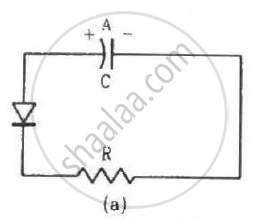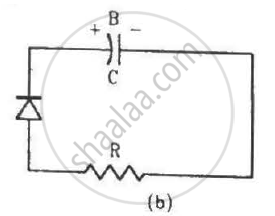Advertisements
Advertisements
प्रश्न
Electric conduction in a semiconductor takes place due to
विकल्प
electrons only
holes only
both electrons and holes
neither electrons nor holes.
उत्तर
both electrons and holes
A hole is created in a semiconductor when a valence electron moves to the conduction band. When potential difference is applied across the semiconductor, the electron drifts opposite to the electric field applied, while the hole moves along the electric field. Therefore, electric conduction takes place in a semiconductor because of both electrons and holes.
APPEARS IN
संबंधित प्रश्न
Draw energy band diagrams of an n-type and p-type semiconductor at temperature T > 0 K. Mark the donor and acceptor energy levels with their energies.
Distinguish between a metal and an insulator on the basis of energy band diagrams ?
Write two characteristic features to distinguish between n-type and p-type semiconductors ?
There are energy bands in a solid. Do we have really continuous energy variation in a band ro do we have very closely spaced but still discrete energy levels?
The conduction band of a solid is partially filled at 0 K. Will it be a conductor, a semiconductor or an insulator?
When an impurity is doped into an intrinsic semiconductor, the conductivity of the semiconductor
Two identical capacitors A and B are charged to the same potential V and are connected in two circuits at t = 0 as shown in figure. The charges on the capacitors at a time t = CRare, respectively,


In a pure semiconductor, the number of conduction election 6 × 1019 per cubic metre. How many holes are there in a sample of size 1 cm × 1 mm?
The band gap for silicon is 1.1 eV. (a) Find the ratio of the band gap to kT for silicon at room temperature 300 K. (b) At what temperature does this ratio become one tents of the value at 300 K? (Silicon will not retain its structure at these high temperatures.)
(Use Planck constant h = 4.14 × 10-15 eV-s, Boltzmann constant k = 8·62 × 10-5 eV/K.)
When a semiconducting material is doped with an impurity, new acceptor levels are created. In a particular thermal collision, a valence electron receives an energy equal to 2kT and just reaches one of the acceptor levels. Assuming that the energy of the electron was at the top edge of the valence band and that the temperature T is equal to 300 K, find the energy of the acceptor levels above the valence band.
Let ΔE denote the energy gap between the valence band and the conduction band. The population of conduction electrons (and of the holes) is roughly proportional to e−ΔE/2kT. Find the ratio of the concentration of conduction electrons in diamond to the in silicon at room temperature 300 K. ΔE for silicon is 1.1 eV and for diamond is 6.1 eV. How many conduction electrons are likely to be in one cubic metre of diamond?
Estimate the proportion of boron impurity which will increase the conductivity of a pure silicon sample by a factor of 100. Assume that each boron atom creates a hole and the concentration of holes in pure silicon at the same temperature is 7 × 1015 holes per cubic metre. Density of silicon 5 × 1028 atoms per cubic metre.
The conductivity of an intrinsic semiconductor depends on temperature as σ = σ0e−ΔE/2kT, where σ0 is a constant. Find the temperature at which the conductivity of an intrinsic germanium semiconductor will be double of its value at T = 300 K. Assume that the gap for germanium is 0.650 eV and remains constant as the temperature is increased.
(Use Planck constant h = 4.14 × 10-15 eV-s, Boltzmann constant k = 8·62 × 10-5 eV/K.)
A window air conditioner is placed on a table inside a well-insulated apartment, plugged in and turned on. What happens to the average temperature of the apartment?
For germanium crystal, the forbidden gas energy gap
A semiconductor is cooled from T.K to T2K its resistance will
In a common-base circuit calculate the change in the base current if that in the emitter current is αmA and a = 0.98
The reaction between α and β parameter of a transistor is given by
The energy required by an electron to jump the forbidden band in silicon at room temperature is about ______.
Which one of the following elements will require the highest energy to take out an electron from them?
Pb, Ge, C and Si
